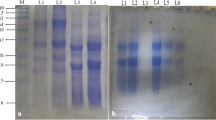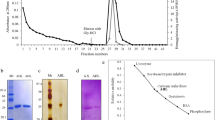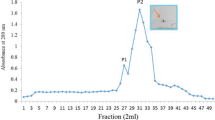Abstract
Butea monosperma is a medicinal plant extensively used in ayurveda and is known for its medicinal applications. Butea monosperma seed powder is used for treating various health ailments including cancer. Although, most parts of the plant are being used in medicine none of them except for seeds are known to contain lectins. A lectin from seeds has been reported earlier, however it was not tested for its anticancer properties. Since plant lectins are known for their anticancer properties, in order to explore anticancer potential of B. monosperma a legume lectin was purified from seeds in a single step by nine fold, by a modified method using affinity chromatography on lactose-Sepharose 4B column and tested for its anticancer properties against human hepatocellular carcinoma cells. SDS PAGE of BML reveals two bands with Mr of 32 and 34 kDa and a minor band of 67 kDa similar to earlier reported BML. Hapten inhibition assay shows that lectin is specific to GalNAc, galactose, lactose and D-Fucose. BML shows strong binding to Hep G2 cells with MFI of 476. MTT assay showed growth inhibitory effect on Hep G2 cells by BML, PTL1 and PTL2 in a dose and time dependent manner. Growth inhibitory effect of BML on Hep G2 cells was compared with two legume lectins, PTL1 and PTL2 from Psophocarpus tetragonolobus of Fabaceae Family. BML, PTL1 and PTL2 showed growth inhibitory effect on Hep G2 cells. The presence of lectin, in B. monosperma seeds contribute for its anticancer properties.



Similar content being viewed by others
Abbreviations
- GalNAc:
-
N-acetylgalactosamine
- MCA:
-
Minimum concentration of protein required for agglutination
- MIC:
-
Minimum inhibitory concentration
- TF:
-
Thomson–Friedenreich
- Tn:
-
Thomson-nouvelle
- MFI:
-
Mean fluorescence intensity
References
Abhilash J, Geethanandan K, Bharath SR, Sadasivan C, Haridas M (2015) The crystallization structure of a lectin from Butea monosperms: in signt in to its glycosyalation and binding of ligands 72:1376–1383. https://doi.org/10.1016/j.ijbiomac.2014.10.004
Bhargava SK (1986) Estrogenic and postcoital anticonceptive activity in rats of butin isolated from Butea monosperma seed. J Ethanopharmol 18(1):95–101
Boopathi S, Polachi N, Mathan G (2016) Isocoreopsin: an active constituent of n-butanol extract of Butea monosperma flowers against colorectal cancer (CRC). J Pharm Anal 1:1. https://doi.org/10.1016/j.jpha.2016.04.007
Geethanandan K, Abhilash J, Bharath SR, Sadasivan C, Haridas M (2011) X-ray structure of a galactose-specific lectin from Spatholobous parviflorous. Int J Biol Macromol 49:992–998. https://doi.org/10.1016/j.ijbiomac.2011.08.021
Goldman M (1968) Fluroscent antibody methods. Academic Press, Nw York
Hardman KD, Ainsworth CF (1972) Structure of concanavalin A at 2.4-A resolution. Biochemistry 11:4910–4919
Higuchi M, Tsuchiya I, Iwai K (1984) Growth inhibition and small intestinal lesions in rats after feeding with isolated winged bean lectin. Agric Biol Chem 48(3):695–701. https://doi.org/10.1080/00021369.1984.10866205
Iqbal Z, Lateef M, Jabbar A, Ghayur MN, Gilani AH (2006) In vivo anthelmintic activity of Butea monosperma against Trichostrongylid nematodes in sheep. Fitoterapia 77:137–140
Laemmli UK (1970) Cleavage of structural proteins during the assembly of the head of bacteriophage T4. Nature 227:680–685
Liener IE, Hill EG (1953) The effect of heat treatment on the nutritive value and hemagglutinating activity of soybean oil meal. J Nutr 49:609–620. https://doi.org/10.1093/jn/49.4.609
Lis H, Sharon N (1986) Lectins as molecules and as tools. Annu Rev Biochem 55:35–67. https://doi.org/10.1146/annurev.bi.55.070186.000343
Lowry OH, Rosebrough NJ, Farr LA, Randall RJ (1951) Protein measurement with the folin phenol reagent. J BiolChem 193:265–275
Manoj N, Suguna K (2001) Signature of quaternary structure in the sequences of legume lectins. Protein Eng Des Sel 14(10):735–745. https://doi.org/10.1093/protein/14.10.735-745
Mathan GF, Saxena AK, Chandan BK, Jaggi BS, Gupta BD, Qazi GN, Balasundaram C, Anand Rajan KD, Kumar VL, Kumar V (2011) Chemoprevention with aqueous extract of Butea monosperma flowers results in normalization of nuclear morphometry and inhibition of a proliferation marker in liver tumors. Phytother Res. https://doi.org/10.1002/ptr.3249
Mathan G, Polachi N, Nagaraj N, Boopathi S (2015) Antiproliferative activity of n-butanol floral extract from Butea monosperma against HCT 116 colon cancer cells; drug likeness properties and in silico evaluation of their active compounds toward glycogen synthase kinase-3β/axin and β-catenin/t-cell facto 8(1). ISSN 0974-2441
Mehta B, Bokadia M (1981) Monospermin: a new alkaloid of Butea monosperma seeds. Chem Ind 3:98
Muzumdar PM, Das MK, Das S (2011) Butea Monosperma (Lam) Kuntz—a comprehensive review. Int J Pharm Sci Nanotechnol 4(2)
Pandey PK, Singh D, Singh S, Khan MY, Jamal F (2014) A nonhost peptidase inhibitor of ~ 14 kDa from Butea monosperma (Lam.) Taub seeds affects negatively the growth and developmental physiology of Helicoverpa armigera. Biochem Res Int. https://doi.org/10.1155/2014/361821
Petrossian K, Banner LR, Steven B (2007) Oppenheimer Lectin binding and effects in culture on human cancer and noncancer cell lines: examination of issues of interest in drug design strategies. Acta Histochem 109(6):491–500
Porath J (1974) General method and coupling procedure. Methods Enzymol 34:13–30. https://doi.org/10.1016/S0076-6879(74)34005-0
Razdak MK, Kapila K, Bhinde NK (1969) Antifertility effect and some pharmacological actions of Butea frondosa seed extracts. Indian J Physiol Pharmacol 13(4):239–249
Sehrawat A, Sultana S (2006) Chemoprevention by Butea monosperma of hepatic carcinogenesis and oxidative damage in male wistar rats. Asian Pac J Cancer Prev 7:140–148
Somani R, Kasture S, Singhai A (2006) Antidiabetic potential of Butea monosperma in Rats. Fitoterapia 77(2006):86–90
Sujata P, Mukherjee S, Barui AK, Ganguly A, Sreedhar B, Patra CR (2015) Green synthesis, characterization of gold and silver nanoparticles and their potential application for cancer therapeutics. Mater Sci Eng C 53:298–309. https://doi.org/10.1016/j.msec.2015.04.048
Sumner JB, Howell SF (1936) Identification of Hemagglutinin of Jack Bean with Concanavalin A. J Bacteriol 32:227–237
Tenzin C, Shukla SK, Kumar V (2010) Chemopreventive and anticancer properties of the aqueous extract of flowers of Butea monosperma. J Ethanopharmacol 219:208–213
Wongkham S, Wongkham C, Trisonthi C, Boonsiri P, Simasathiansophon S, Atisook K (1994) Isolation and properties of a lectin from the seeds of Butea monosperma. Plant Sci. https://doi.org/10.1016/0168-9452(94)90199-6
Wongkham S, Taketa K, Liu M, Taga H (1996) Affinity electrophoretic determination of oligosaccharide specificity of Butea monosperma agglutinin. Electrophorosis 17:98–103. https://doi.org/10.1002/elps.1150170117
Zacharius RM, Zell TE, Morrison JH, Woodlock J (1969) Glycoprotein staining following electrophoresis on acrylamide gels. Anal Biochem 30:148–152
Acknowledgements
SRI would like to thank UGC for the funding from under UPE (F.No14-4/2012(NS/PE) and KYH would like to thank Rajiv Gandhi National Fellowship for Students with Disabilities (RGNFD) under UGC (No. F./2015-16/R GNF-2015-17-KAR -1523).
Author information
Authors and Affiliations
Corresponding author
Ethics declarations
Conflict of interest
Authors don’t have any conflict of interest to declare concerning to the present work.
Additional information
Publisher's Note
Springer Nature remains neutral with regard to jurisdictional claims in published maps and institutional affiliations.
Rights and permissions
About this article
Cite this article
Hiremath, K.Y., Hegde, P., Sharma, M. et al. A modified method for purification of N-acetylgalactosamine specific lectin from Butea monosperma seeds and its effect on human hepatocellular carcinoma cell growth. J. Plant Biochem. Biotechnol. 28, 397–404 (2019). https://doi.org/10.1007/s13562-019-00488-1
Received:
Accepted:
Published:
Issue Date:
DOI: https://doi.org/10.1007/s13562-019-00488-1




